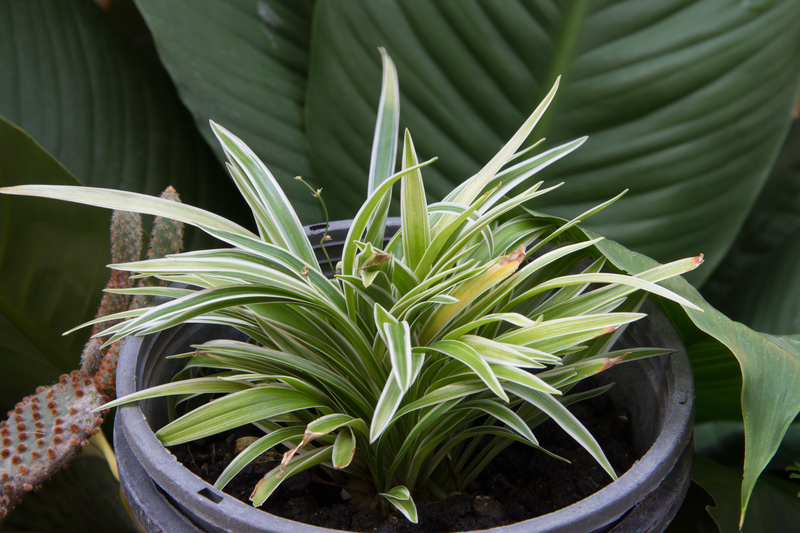Revolutionize Urban Living with Vertical Gardening Techniques
Posted on 30/06/2025
Revolutionize Urban Living with Vertical Gardening Techniques
Urban environments are constantly evolving, pressing inhabitants and urban designers to find innovative ways to create greener, healthier, and more sustainable cities. One such innovation that is garnering global attention is vertical gardening. Vertical gardening techniques enable city dwellers to turn even the smallest spaces into lush, productive gardens, transforming the concrete jungle into a living, breathing oasis. In this article, we'll explore how you can revolutionize urban living with vertical gardening techniques by understanding their benefits, types, practical applications, and step-by-step guides to get started.
What is Vertical Gardening?
Vertical gardening refers to the practice of cultivating plants on vertically suspended panels, trellises, walls, or structures rather than traditional horizontal plots. This innovative approach maximizes the use of available space, which is especially beneficial in densely populated urban areas where ground space is at a premium.
- Living walls or green walls feature entire structures covered in thriving plants.
- Vertical planters use stacked pots or shelves to grow plants upwards.
- Trellises and lattice systems help climbing or vining plants grow vertically.
- Pocket gardens utilize fabric or modular pockets for planting on walls.

Advantages of Vertical Gardening in Urban Areas
There are myriad reasons why urban residents and city planners are incorporating vertical gardening methods into their communities. Some of the most compelling benefits include:
- Space Efficiency: Vertical gardening allows for the creation of gardens in narrow alleyways, on balconies, or alongside fences, making it ideal for apartments and small homes.
- Improved Air Quality: Plants in vertical gardens can filter out pollutants and carbon dioxide, improving the atmosphere and reducing the urban heat island effect.
- Insulation and Energy Savings: Living walls act as natural insulators, helping to regulate indoor temperature and save on electricity.
- Aesthetic Enhancements: Lush green walls and vertical gardens beautify drab urban landscapes, contributing to mental well-being.
- Noise Reduction: Plants help absorb sound, making vertical gardens a noise buffer in busy neighborhoods.
- Boosts Biodiversity: Even a small vertical garden can attract pollinators and create habitats for city wildlife.
- Promotes Food Security: Edible vertical gardens provide fresh herbs, fruits, and vegetables, reducing dependency on supermarkets.
Types of Vertical Gardening Techniques
Regardless of your available space, skill level, or budget, there's a vertical gardening technique that can suit your needs. Understanding the main types will help you choose the best method to revolutionize your urban living space.
1. Living Walls (Green Walls)
Living walls are architecturally integrated structures planted with a variety of greenery. These can be DIY projects or professionally installed systems that incorporate irrigation and drainage. Living walls are particularly impressive for large spaces like building facades, indoor lobbies, or expansive patios.
- Contains: Built-in planting containers, waterproof membranes, and irrigation systems.
- Ideal for: Commercial buildings, apartments, and public spaces.
2. Modular Vertical Planting Systems
These systems use prefabricated modules--like stackable pots or grids--to make vertical gardening accessible and customizable. They work well on fences, balconies, or interior feature walls and are perfect for renters or those seeking flexibility.
- Materials: Plastic, wood, metal, or recycled materials.
- Pros: Modular, easy to assemble, scalable as needed.
3. Hanging Gardens
Hanging gardens utilize baskets, pots, or bottles hung vertically on walls or from ceilings. They're popular for growing herbs, strawberries, and trailing ornamentals in kitchens or balconies.
- Best for: Small spaces, patios, and windowsills.
- Examples: Hanging shoe organizers, ladder racks, or shelves with suspended pots.
4. Trellises and Climbing Frames
Trellises provide a perfect support for climbing plants such as beans, peas, or morning glory. Integrate these with fences or create free-standing units for rapid vertical growth.
- Materials: Metal, wood, bamboo.
- Advantages: Durable, low-cost, natural beauty added by climbing foliage.
5. Gutter Gardens
Upcycled gutter gardens make use of old rain gutters to plant shallow-rooted crops on wall surfaces or balcony railings. A cost-effective and eco-friendly solution!
- Great for: Lettuce, spinach, radishes, and herbs.
- Tip: Ensure adequate drainage and sunlight exposure.
How to Start Your Own Vertical Garden: Step-by-Step Guide
Ready to embrace this urban gardening revolution? Follow these steps to make your own vertical urban garden and elevate your city living experience.
Step 1: Assess Your Space
- Location: Identify a wall, fence, balcony, or even an indoor area with sufficient light.
- Sunlight: Observe how much sunlight your chosen spot gets. Some plants thrive in full sun, while others prefer shade.
- Weight-bearing Capacity: For large installations, ensure your wall or structure can support extra weight.
Step 2: Choose the Right System
- DIY or Pre-made: Decide between a homemade system using recycled materials or purchasing a kit.
- Permanent or Mobile: Are you staying long-term, or do you need something portable?
- Budget: Factor in the cost of containers, framework, irrigation, and plants.
Step 3: Select Your Plants
Not all plants are ideal for vertical gardening methods. Consider:
- Shallow-rooted plants: Such as lettuce, spinach, strawberries, herbs, and succulents.
- Climbers and Vines: Tomatoes, peas, beans, and flowering vining species.
- Ornamentals: Ferns, mosses, ivies, orchids.
- Drought-tolerant species: Excellent for busy individuals or sunny, dry locations.
Step 4: Install Irrigation and Drainage
- Self-watering systems: Automatic drip irrigation simplifies maintenance.
- Manual watering: Use watering cans or hoses with gentle spray nozzles.
- Drainage: Ensure excess water can exit plant containers to prevent root rot.
Step 5: Plant and Maintain
- Plant densely: Vertical setups often benefit from tighter planting, controlling evaporation and weed growth.
- Regular feeding: Use diluted liquid fertilizer for regular nutrient supply.
- Prune and harvest: Keep plants healthy by removing dead leaves and frequently harvesting edible crops.
Urban Spaces Transformed by Vertical Gardening Techniques
The impact of vertical gardening can be seen in cities all over the world. Let's look at remarkable examples where vertical gardens have revolutionized urban living:
1. The Bosco Verticale, Milan, Italy
Literally meaning "Vertical Forest", Bosco Verticale is an award-winning pair of residential towers featuring nearly 1,000 trees, and over 20,000 shrubs and plants. The lush facades bring nature right to residents' doorsteps, reduce air pollution, and provide homes for urban wildlife.
2. One Central Park, Sydney, Australia
This residential tower boasts living walls spanning 1,120 square meters, with integrated irrigation and automated hydroponic systems. The result: a sustainable, energy-efficient building with unparalleled urban garden views.
3. Musee du quai Branly, Paris, France
The museum's green wall by botanist Patrick Blanc is covered with 15,000 tropical and sub-tropical plants from around the world, demonstrating the power of living walls to transform public spaces and city aesthetics.
4. Singapore's Supertree Grove
The iconic "Supertrees" in Singapore's Gardens by the Bay blend vertical gardens with advanced technologies, supporting over 200 plant species each and serving as environmental engines for the community.
Tips and Tricks to Maximize Your Vertical Garden's Success
- Rotate crops and plants: Periodically change out plants to prevent soil nutrient depletion and pest build-up.
- Integrate smart watering systems: Sensors and timed irrigation systems reduce water waste and keep plants healthy.
- Choose local and resilient species: Native plants are usually more pest- and disease-resistant.
- Add lighting indoors: Use grow lights to supplement sunlight for indoor vertical gardens.
- Use organic soil and fertilizers: Healthy soil ensures vibrant growth and delicious harvests in edible gardens.
Overcoming Common Challenges in Vertical Urban Gardening
While vertical gardening methods are accessible and rewarding, they're not without challenges. Here are common issues and solutions:
- Watering difficulties: Vertical setups dry out faster; dripping or automated systems solve the issue.
- Weight concerns: Choose lightweight materials and plants for delicate structures. Modular designs lessen the load.
- Pest management: Use integrated pest control (beneficial insects, neem oil) and regular checks to keep infestations at bay.
- Sunlight limitations: Orient gardens for maximum exposure or use shade-tolerant species if light is limited.
- Initial cost: DIY solutions and upcycling can dramatically reduce expenses for beginners.
Future Innovations in Vertical Gardening
The future of urban vertical gardening is bright, fueled by advances in technology, materials, and design. Exciting developments include:
- Smart gardens: Internet-connected sensors monitor soil moisture, sunlight, and deliver nutrients remotely.
- Hydroponics and aeroponics: Soil-less cultivation methods maximize yield and efficiency within compact spaces.
- 3D-printed modular planters: Utmost customization and eco-friendly materials for personal or commercial use.
- AI-assisted plant management: Algorithms optimize plant health, irrigation, and harvest times for urban growers.
Conclusion: Transform Your City Life with Vertical Gardening
Revolutionize urban living with vertical gardening techniques--a solution that's as sustainable as it is beautiful. From space-saving pocket gardens to spectacular living walls, vertical urban gardening offers environmental, social, and personal benefits that can truly transform our cities. Whether you're a city dweller with a tiny apartment balcony or an architect designing the next green skyscraper, vertical gardening techniques are your key to a greener, healthier, and more vibrant urban future.
Start your vertical garden today, and help shape tomorrow's cities into living works of art--one wall at a time!

Frequently Asked Questions (FAQs) About Vertical Urban Gardening
Can I build a vertical garden indoors?
Absolutely! Many vertical garden techniques are well-suited to indoor environments. Opt for species that thrive in low light or supplement natural sunlight with grow lights. Living walls or modular pocket gardens are popular indoor options.
What are the best edible plants for vertical gardens?
Herbs (such as basil, mint, cilantro), lettuce, strawberries, cherry tomatoes, radishes, and dwarf pea or bean varieties are excellent choices. Choose compact, shallow-rooted species to maximize your harvest.
How much maintenance does a vertical garden require?
Maintenance depends on the system and plant selection. Automated irrigation makes upkeep much easier, while manual gardens need consistent watering and feeding. Regular pruning, harvesting, and pest checks are necessary.
Is vertical gardening expensive?
While advanced, integrated living walls can be costly, many vertical gardening installations can be built using recycled or inexpensive materials. DIY projects often cost less and allow for greater creativity.
Are there eco-friendly vertical gardening systems?
Yes! Many systems use recycled materials or sustainable woods and plastics. Hydroponic vertical gardens can use up to 90% less water than traditional gardening, making them ideal for sustainable cities.
Further Reading and Resources
- Vertical Gardening: The Complete Guide
- Tips for Starting Your Own Urban Vertical Garden
- Vertical Gardening How-To's from Gardener's Supply
- Vertical Gardens in Modern Architecture
Embrace vertical gardening techniques and play an active role in creating greener cities for future generations--your wall, your rules, your urban revolution!


